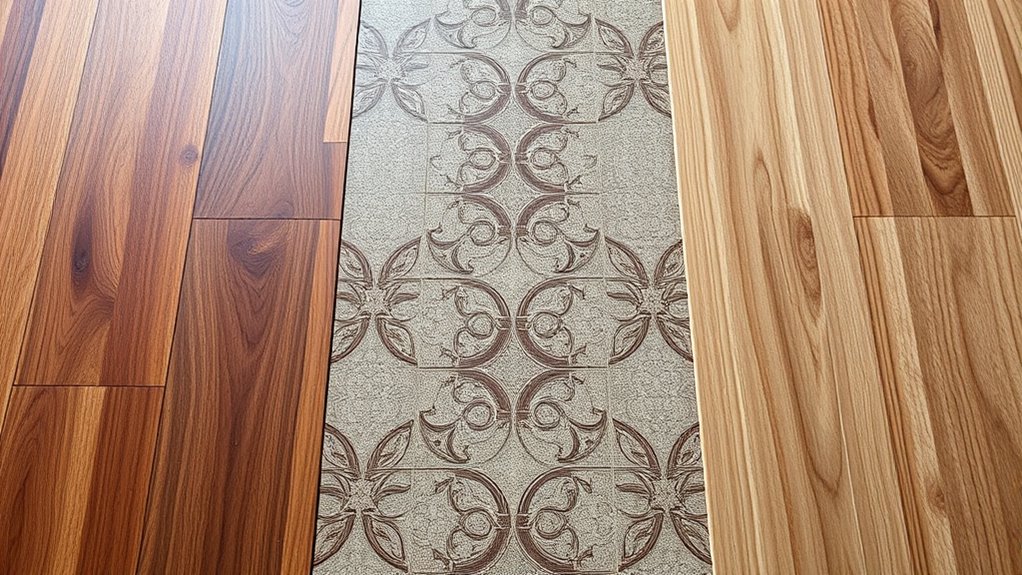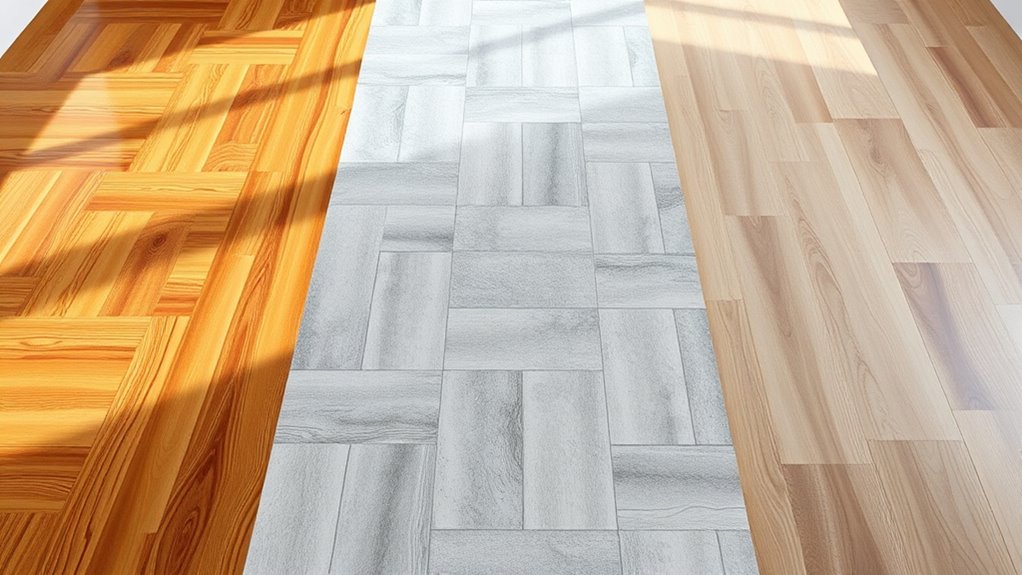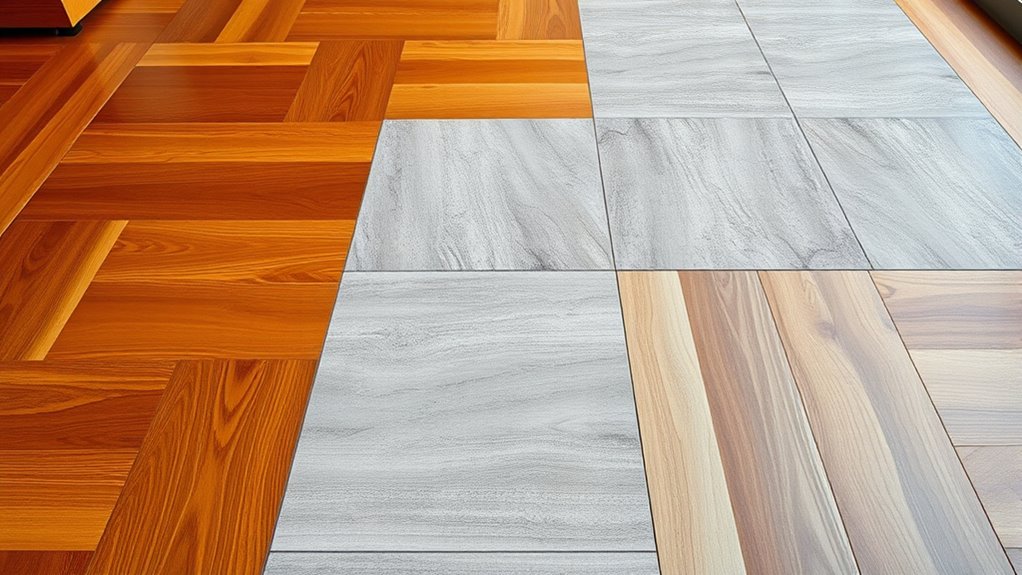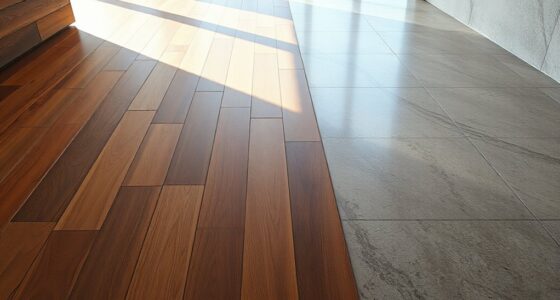When choosing between hardwood, tile, and laminate flooring, consider your style, durability needs, and budget. Hardwood offers natural beauty but requires more maintenance, while tile is highly durable and moisture-resistant, perfect for high-traffic or wet areas. Laminate provides a budget-friendly, easy-to-install option with decent durability. Think about how each fits your decor and lifestyle; exploring further will help you pick the perfect flooring for your space.
Key Takeaways
- Consider aesthetic preferences, such as color, pattern, and style, to ensure the flooring complements your decor.
- Evaluate durability and maintenance needs, especially for pet resistance, moisture tolerance, and ease of cleaning.
- Balance budget and installation complexity; hardwood offers longevity but can be costlier, while laminate is budget-friendly and easier to install.
- Match flooring patterns and textures with your overall design theme, like rustic farmhouse or modern styles.
- Assess long-term care requirements and appliance maintenance to select a flooring option that suits your lifestyle and extends lifespan.
Comparing Aesthetics and Design Options

When choosing flooring, it’s important to take into account how it will impact the overall look and feel of your space. Color customization allows you to select shades that complement your decor, creating a cohesive environment. Whether you prefer warm tones or cool hues, you can tailor your flooring to match your style. Pattern versatility also plays a key role; some options, like tiles or patterned laminates, offer a variety of designs from classic to modern, adding visual interest. Hardwood floors may have subtle grain patterns that enhance natural beauty, while tiles can feature intricate motifs. Additionally, considering the rustic decor and other farmhouse elements can help ensure your flooring choice aligns with your overall aesthetic. By considering both color options and pattern versatility, you guarantee your flooring choice aligns with your aesthetic vision, making your space uniquely yours.
Assessing Durability and Maintenance Needs

While choosing a flooring style that matches your aesthetic is important, it’s equally *vital* to think about how well it holds up over time. Durability and maintenance needs vary across options, especially if you have pets or high moisture areas. For pet resistance, hardwood can scratch easily, while tile offers excellent pet resistance. Laminate is moderately resistant but less moisture-tolerant. Consider moisture tolerance if your space is prone to spills or humidity—tile handles moisture best, while hardwood and laminate need more care. Use this table to compare:
| Flooring Type | Pet Resistance | Moisture Tolerance | Maintenance Ease | Cost |
|---|---|---|---|---|
| Hardwood | Moderate | Low | Moderate | $-$$$ |
| Tile | Excellent | High | Easy | $$-$$$ |
| Laminate | Good | Moderate | Easy | $$ |
Additionally, understanding how appliance maintenance can extend the lifespan of your flooring is beneficial. Choose wisely based on your lifestyle.
Cost and Installation Considerations

Considering cost and installation requirements is essential to making a smart flooring choice. Your budget constraints will influence which options are feasible, as hardwood, tile, and laminate vary in price and long-term value. Hardwood tends to be more expensive upfront but offers durability, while laminate is budget-friendly and easier to install. Installation complexity also matters; hardwood and tile often require professional help, increasing labor costs, whereas laminate can sometimes be a DIY project. Keep in mind that simpler installations generally save money and time. Additionally, installation techniques can impact the overall quality and longevity of your flooring. Balancing your budget with installation needs will help you select the best flooring that fits your space, style, and financial plan. Carefully evaluate these factors to avoid surprises and ensure a smooth, cost-effective upgrade.
Frequently Asked Questions
Which Flooring Type Is Best for Allergy Sufferers?
You should choose hypoallergenic flooring for allergy sufferers, as it minimizes allergens like dust, pet dander, and mold. Tile is an excellent option because it’s allergy-friendly and easy to keep clean, reducing irritants. Look for allergy-friendly materials such as ceramic or porcelain tiles. These materials don’t trap allergens like carpet or some laminates, providing a healthier indoor environment and making your space more comfortable for allergy sufferers.
How Environmentally Friendly Are Hardwood, Tile, and Laminate Options?
Hardwood, tile, and laminate flooring all have eco-friendly options. Hardwood is sustainable when sourced from responsibly managed forests, using sustainable materials and eco-friendly production methods. Tile, especially ceramic or porcelain, often uses natural raw materials and can be very durable, reducing waste. Laminate can be eco-friendly if made with recycled materials and produced with environmentally conscious processes. Overall, your choice depends on sourcing and manufacturing practices, so look for certifications to guarantee environmentally friendly options.
Can Flooring Be Installed Over Existing Surfaces?
Think of your floor as a canvas waiting for new art. You can install new flooring over existing surfaces, but you need to assess the condition first. Proper existing surface preparation is essential to avoid installation challenges, like unevenness or damage that could compromise the new layer. If you skip these steps, the new floor might not settle properly, leading to issues down the line. Take your time to prepare for a seamless, lasting upgrade.
What Are the Best Flooring Choices for High-Moisture Areas?
For high-moisture areas, you should opt for moisture-resistant materials like ceramic or porcelain tile, which are waterproof flooring options that handle humidity and spills well. Luxury vinyl planks and waterproof laminate also work, offering durability and water resistance. Avoid hardwood, as it absorbs moisture and can warp. Choosing the right waterproof flooring options guarantees your space stays protected and maintains its appearance over time.
How Do Flooring Options Affect Home Resale Value?
Imagine your home’s floors as the foundation of its charm—your choice of material can markedly boost resale value. Hardwoods often attract buyers with their timeless appeal, positively impacting resale value factors. Tile’s durability adds to its allure, while laminate offers affordability but may slightly lower resale appeal. Your flooring material impacts how potential buyers see your home, so opt for options that balance style and longevity to maximize your investment.
Conclusion
When choosing your flooring, remember that hardwood offers timeless elegance, while tile provides durability and easy maintenance. Laminate balances affordability with style. Did you know that over 50% of homeowners upgrade their floors within the first five years? So, consider your aesthetic, lifestyle, and budget carefully. Making an informed decision today guarantees you’ll love your space for years to come—after all, your floors set the foundation for your home’s vibe!










